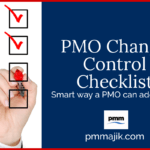 When a project comes to an end, one of the steps will be to close the PMO supporting the project. The reason being that the services are no longer required and the resources can deliver more value by being redeployed.
When a project comes to an end, one of the steps will be to close the PMO supporting the project. The reason being that the services are no longer required and the resources can deliver more value by being redeployed.
In the same way that there is a process for project closure, the same applies for a PMO. It is important that the closure is conducted in a structured way.
Below is a checklist of key steps that should form part of the PMO closure.
1. Resource Management
This is the most important item. There must be a defined approach for the roll-off of resources from the PMO. It is rare for the entire PMO team to finish on the same day. What typically happens is that the team reduces over a period of time. This is logical as the requirements from the project should also be reducing as it nears closure.
The plan can be a simple table listing each resource, their role and planned roll-off. For contractors, it is helpful to include the contract end date as this may influence when a resource is rolled-off.
As part of the planning, it is important to consider the skills and knowledge for each resource. There will be resources that it is important to retain for the benefit of the organization. Therefore, those resources must be identified and action taken to find new roles to retain the knowledge.
Important: do not wait until the PMO closure to think about how the resources will be deployed as it normally takes some time to reallocate resources. It is also important to let people know that you wish to retain them, especially if they have important skills, otherwise they may find a new role themselves outside of the organization.
2. PMO Review
The project closure process aims to collect what went well and what could have been done better. The same applies to the PMO. A review should be completed on what went well with the aim that the other PMO’s in the organization can benefit.
In a similar way, what did not go well should be understood. The aim being that other PMO’s can make changes and improve the outcomes.
3. Knowledge Transfer
Linked closely to the PMO Review, it is important that knowledge is transferred and retained by the organization. This helps maximize the benefit from the investment.
The PMO may have developed templates, processes, presentations, Sharepoints, etc. This information should be stored in a way that makes it accessible to other PMO’s. A readymade set of PMO templates and processes will help speed up the mobilization of other PMO’s.
4. House Keeping
This means making sure that all outstanding items are either closed or transferred. For example, it is good practice to make sure that all projects are closed (i.e. risks, issues, dependencies, milestones, change controls, etc). Final status reports completed and project officially closed.
It maybe that there are still outstanding benefits to be realized from the project. Therefore, arrangements need to be made to transfer the tracking to ensure that they are not forgotten and the benefits are realized.
Summary
The above provides a number of key points that need to be considered when closing a PMO. By having a structured approach it should help ensure that key resources and knowledge are retained.




